
Verify whether the indicated numbers are the zeros of the given polynomial
$p\left( x \right)={{x}^{3}}-6{{x}^{2}}+11x-6,x=1,2,3$
Answer
568.2k+ views
Hint: Recall the definition of a zero of a polynomial. If ${{x}_{0}}$is a zero of a polynomial p(x), then we have $p\left( {{x}_{0}} \right)=0$. Hence determine at which point p(x) vanishes. Those points are the roots of p(x).
Complete step-by-step answer:
Alternatively, use synthetic division to determine whether the given points are the roots of the polynomial or not.
We know that if ${{x}_{0}}$ is a root of a polynomial p(x), then we have $p\left( {{x}_{0}} \right)=0$.
Checking x = 1
We have $p\left( x \right)={{x}^{3}}-6{{x}^{2}}+11x-6$
Substituting x = 1 in the p(x), we get
$p\left( 1 \right)={{1}^{3}}-6{{\left( 1 \right)}^{2}}+11-6=1-6+11-6=0$
Since p(1) = 0, we have x = 1 is a zero of the polynomial p(x)
Checking x =2
We have $p\left( x \right)={{x}^{3}}-6{{x}^{2}}+11x-6$
Substituting x = 2 in the p(x), we get
$p\left( 2 \right)={{2}^{3}}-6{{\left( 2 \right)}^{2}}+11\times 2-6=8-24+22-6=0$
Since p(2) = 0, we have x = 2 is a zero of the polynomial p(x)
Checking x= 3
We have $p\left( x \right)={{x}^{3}}-6{{x}^{2}}+11x-6$
Substituting x = 3 in the p(x), we get
$p\left( 3 \right)={{3}^{3}}-6{{\left( 3 \right)}^{2}}+11\times 3-6=27-54+33-6=0$
Since p(3) = 0, we have x = 3 is a zero of the polynomial p(x).
Hence x = 1,2,3 are the zeros of the given polynomial p(x).
Note: Alternative method: Synthetic division: Best method.
In this method, we start by writing coefficients of the polynomial in order from the highest degree to the constant term. If in between some degree terms are missing we set their coefficient as 0.
Hence $p\left( x \right)={{x}^{3}}-6{{x}^{2}}+11-6$ will be written as shown below

Now the point which has to be substituted(say x= 1) is written as follows

0 is placed below the first term
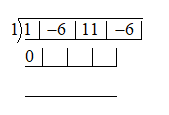
Now the terms under the same column are added. The sum is then multiplied with the root, and the product is written under the coefficient of the next term.
Hence, we have
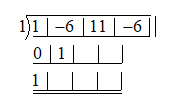
Continuing in this way we have the following
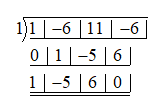
Since the last sum is 0, we have $p\left( 1 \right)=0$. This method also tells you what the quotient will be when p(x) is divided by x-1. Here it will be $1\left( {{x}^{2}} \right)-5\left( x \right)+6={{x}^{2}}-5x+6$
Similarly creating tables for x = 2 and x = 3, we get
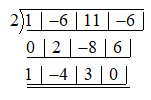
Since the last sum is 0, we have $p\left( 2 \right)=0$
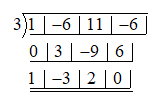
Since the last sum is 0, we have $p\left( 3 \right)=0$
Hence x =1,2,3 are the roots of the given polynomial.
Complete step-by-step answer:
Alternatively, use synthetic division to determine whether the given points are the roots of the polynomial or not.
We know that if ${{x}_{0}}$ is a root of a polynomial p(x), then we have $p\left( {{x}_{0}} \right)=0$.
Checking x = 1
We have $p\left( x \right)={{x}^{3}}-6{{x}^{2}}+11x-6$
Substituting x = 1 in the p(x), we get
$p\left( 1 \right)={{1}^{3}}-6{{\left( 1 \right)}^{2}}+11-6=1-6+11-6=0$
Since p(1) = 0, we have x = 1 is a zero of the polynomial p(x)
Checking x =2
We have $p\left( x \right)={{x}^{3}}-6{{x}^{2}}+11x-6$
Substituting x = 2 in the p(x), we get
$p\left( 2 \right)={{2}^{3}}-6{{\left( 2 \right)}^{2}}+11\times 2-6=8-24+22-6=0$
Since p(2) = 0, we have x = 2 is a zero of the polynomial p(x)
Checking x= 3
We have $p\left( x \right)={{x}^{3}}-6{{x}^{2}}+11x-6$
Substituting x = 3 in the p(x), we get
$p\left( 3 \right)={{3}^{3}}-6{{\left( 3 \right)}^{2}}+11\times 3-6=27-54+33-6=0$
Since p(3) = 0, we have x = 3 is a zero of the polynomial p(x).
Hence x = 1,2,3 are the zeros of the given polynomial p(x).
Note: Alternative method: Synthetic division: Best method.
In this method, we start by writing coefficients of the polynomial in order from the highest degree to the constant term. If in between some degree terms are missing we set their coefficient as 0.
Hence $p\left( x \right)={{x}^{3}}-6{{x}^{2}}+11-6$ will be written as shown below

Now the point which has to be substituted(say x= 1) is written as follows

0 is placed below the first term

Now the terms under the same column are added. The sum is then multiplied with the root, and the product is written under the coefficient of the next term.
Hence, we have

Continuing in this way we have the following

Since the last sum is 0, we have $p\left( 1 \right)=0$. This method also tells you what the quotient will be when p(x) is divided by x-1. Here it will be $1\left( {{x}^{2}} \right)-5\left( x \right)+6={{x}^{2}}-5x+6$
Similarly creating tables for x = 2 and x = 3, we get

Since the last sum is 0, we have $p\left( 2 \right)=0$

Since the last sum is 0, we have $p\left( 3 \right)=0$
Hence x =1,2,3 are the roots of the given polynomial.
Recently Updated Pages
How do you convert r6sec theta into Cartesian form class 10 maths CBSE

How do you solve dfrac5y3dfracy+72y6+1 and find any class 10 maths CBSE

If sin A+B1 and cos AB1 0circ le left A+B rightle 90circ class 10 maths CBSE

On the number line 10 is to the of zero class 10 maths CBSE

How do you solve 5xge 30 class 10 maths CBSE

In the following sentence supply a verb in agreement class 10 english CBSE

Trending doubts
Write an application to the principal requesting five class 10 english CBSE

Why is there a time difference of about 5 hours between class 10 social science CBSE

Write a letter to the principal requesting him to grant class 10 english CBSE

The Equation xxx + 2 is Satisfied when x is Equal to Class 10 Maths

What is the median of the first 10 natural numbers class 10 maths CBSE

Write examples of herbivores carnivores and omnivo class 10 biology CBSE




